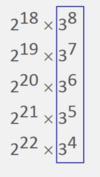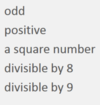Practice Questions & Answers Flashcards
What is the main thing you need to remember about this question?

The answer is B.
You need to remember here that zero is neither positive nor negative, so statement I can’t be true because if any of the variables is zero the product of them all is zero.
Factorial and division:


Pick one of the following:
A) 2
B) 3
C) 5
D) 7
E) 11
What do you need to remember about this question? (what is the main thing you learned?)

A square of an integer has each prime factor twice, since 392 is missing one 2 to be able to fully squared, y needs to be 2 to be able to x².
So remember, a sqaured number has twice the number of prime factors as the base number.

Remainder Question
A) 3/4
B) 1/3
C) 5/8
D) 5/7
E) 7/8
What do you need to remember here?

You need to remember that the remainder is based on the numerator not the denominator…
Also you need to know to solve these remainder problems when they give you the final answer. The remaider will essentially be equal to R = (a/b) * b if a is smaller than b, which means that the remainder is equal to a.

How do you approach this type of prime number question?
A) 0
B) 1
C) 2
D) 3
E) 4

You got to do prime factorisation, so practice breaking up numbers quick.

What do you need to remember about this question?
A) 2
B) 6
C) 15
D) 16
E) 30

Remember to clearly differentiate the variables. The GMAT sometimes tries to confuse you with similar looking variables. In this case 〈〈x〉〉 represents a different number to x, so you might as well right it as ‘y’. The 3 and 5 factors are not a feature of this ‘y’ variable, instead all we know that its bigger than x and it is even.

Factors: How do you need to approach this question?
A) A!
B) B!
C) Combined
D) Divided
E) E..imposssible

For 8 to be a factor, the brackets need to have the factors 2 and 4 or one of the brackets needs to have the factor 8. We determine this from the information given.

If n = 20!, then n is divisible by
A)
B)
C)
D)
E)


If {n} is the smallest integer greater than n, what is the value of {1.5} - {0} - {-1}


The product of four consecutive integers is always:
What do you need to remember with this question?

0 is divisible by any number that’s why ‘divisible by 8’ is right.
On the other hand, 0 is not positive or negative.

If x/6 is a positive integer, does x have more than two different positive prime factors?
(1) x/4 is a positive integer
(2) x/9 is a positive integer
What do you need to remember with this question?

What you need to remember is the wording and to really pay attention to it. They want to know if there are more than 2 positive prime factors, not whether there are 2 prime factors.

What has this question taught you about how you should approach data suffiency questions?
A!
B!
Combined
Divided
E..impossible

You need try each statement in isolation, if neither work, try to see if they work by combining, if not its E.

Data Suffiency: What did you learn with this question?

That zero is considered even (and an integer). More specifically, a number ending in zero is even and therefore has to be considered in this case.
10*10 is 100, thereby complying with the second statement. Thus knowing that two digit numbers which end with 6 also end with 6 when squared doesn’t give us all the information to answer the question.
As result, we need both statements to be able to answer the question.

Data Suffiency: Geometry

Apparently you only need to have statment (1) because it shows that the diagonal lines are parallel and tells us that x = z, which then allows us to calculate y based on the fact, that the small + large angle in these intersections is equal to 180º.

Data Sufficiency: Geometry
A!
B!!
Combined
Divided
E..impossible

Which two lines are parallel?
a and b
a and c
a and d
d and e
d and f


In the figure, if x and y are integers, how many different values can x have?
0
1
2
4
6

You need to consider 6y here aswell!
So go thorugh the x values and think logically what values of y will work given the coefficient 6.

12 is 15% of x. What is x?
What is the best method for solving these?
12/x = 15/100
Solve for x.
Which is large m or n?

The answer is C.
It can’t be just A because if m and n are both negative, the inequality could work but it will erroneously pick

Which letter represents the same positive digit in the decimal form of 1/11 and 1/13?

The answer is d
Make sure to read the question properly.

The population of two cities, A and B, in thousands, is 142 and 61, respectively. The population of city A is approximately what percent greater than the population of city B?
What can you do to solve these sorts of questions?

You can simplify to the numbers so that easier to work with an you can get a close estimate of what the answer would be.

How should you approach this question?

If the numbers are too crazy to mentally calculate you need to make estimations. In this case specifically you need to calculate the extremes of the reciprocal sum for a, all of them 1/11 and all 1/20.

What did you do wrong here?

You didn’t read the question properly. They are asking for the percent of smoking members that are non-cigar smokers, not the percent of the total congress. You need to do 21/70.
When r is rounded to the nearest integer, the result is 1? Is r an integer?





































































































